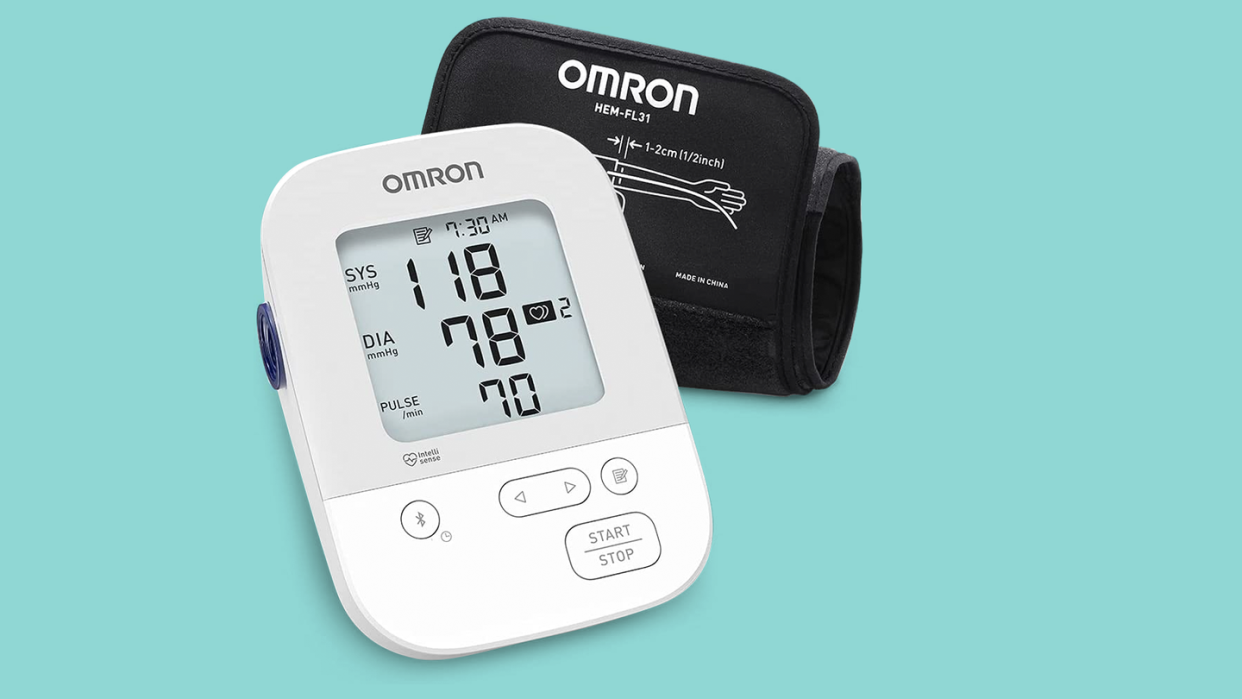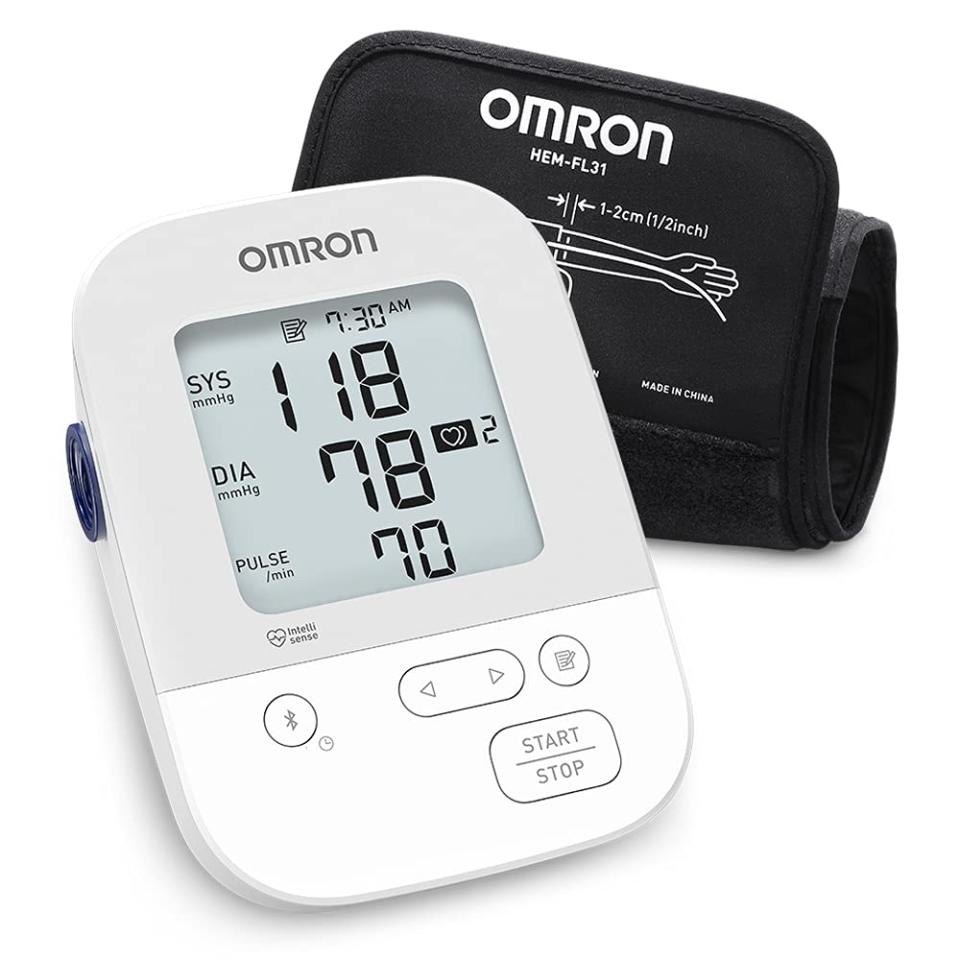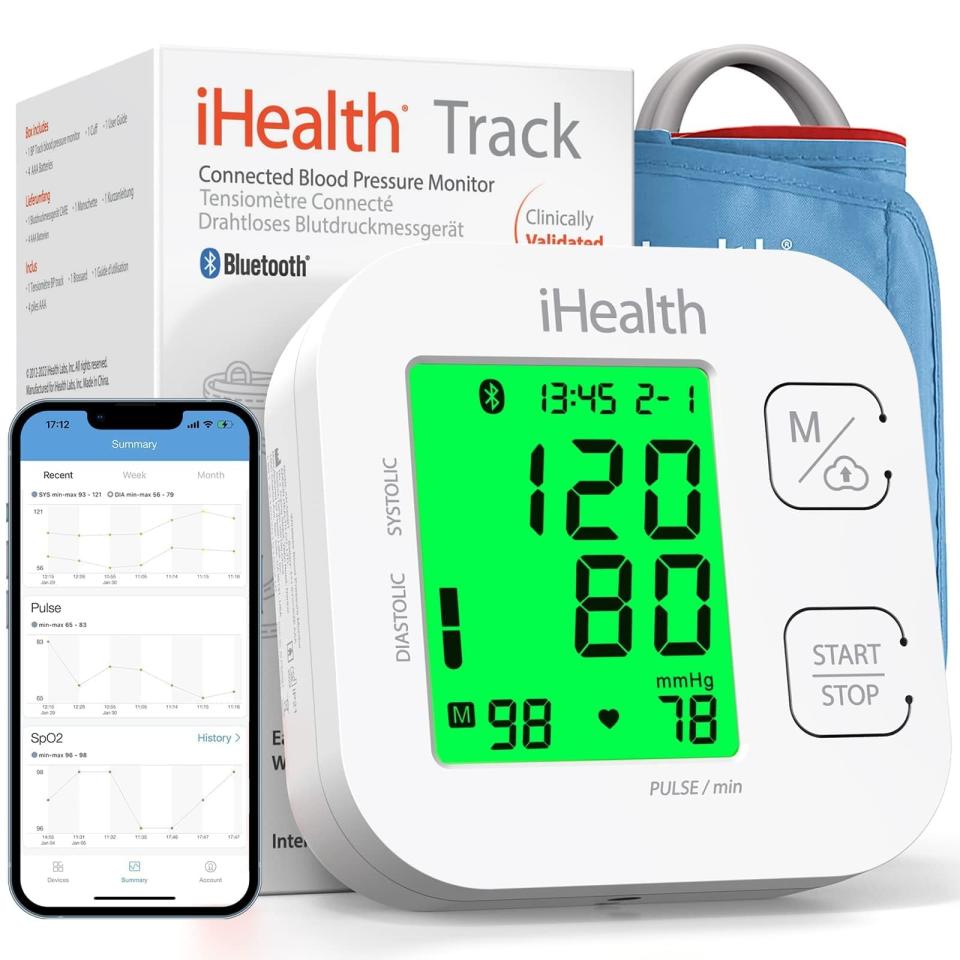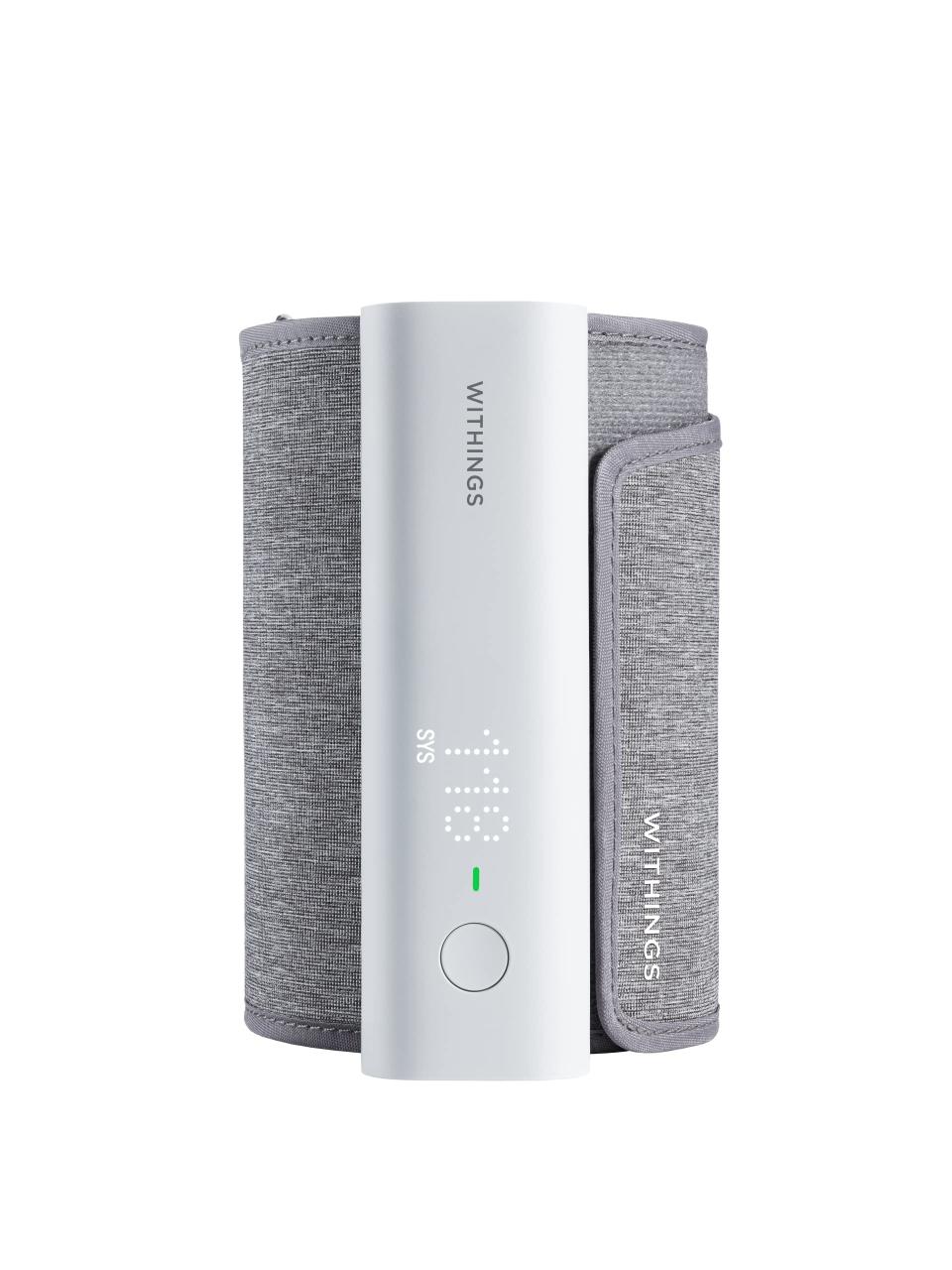Why You Should Invest in an At-Home Blood Pressure Monitor, According to Cardiologists

"Hearst Magazines and Yahoo may earn commission or revenue on some items through these links."
Think about how stressful it can be going to a doctor’s office and searching for parking, worrying about missing work and trying to get all your questions answered before your doctor runs to the next patient — that’s the opposite of an ideal scenario for getting an accurate measure of your blood pressure. Tracking your blood pressure might not be part of your morning routine right now, but just like brushing your teeth, it’s a relatively easy step you can take to protect your health. In fact, it takes less than 10 minutes a day to measure your BP with an at-home blood pressure monitor, and it gives you and your doctor lots of helpful data to protect your cardiovascular health.
“We focus in on using novel techniques to really help prevent heart disease,” says Francoise Adeline Marvel, M.D., a cardiologist and assistant professor of medicine at Johns Hopkins Medicine. “Home blood pressure monitoring using blood pressure cuffs that are connected through Bluetooth allows patients to take their blood pressure and have it synced with their smartphone. It’s something we do a lot now.” Of course, your blood pressure monitor doesn’t need to have Bluetooth capability as long as you write down all of your readings and share them with your doctor. When your physician sees a detailed record of your blood pressure history, it gives them a much clearer picture of your health than a one-off reading at their office.
The first step to taking your blood pressure is to buy a blood pressure cuff that’s designed to be used at home. There are a variety of different models available at affordable prices, so we consulted with top cardiologists to find out which ones they think are the best blood pressure monitors for at-home measurements. Use their guidance below to purchase the right blood pressure cuff for your needs.
Of course, keep in mind that the information here is just a starting point. You'll see we only selected three because while there are many options on the internet, we're only highlighting those that have been recommended by cardiologists. As always, the best thing to do is talk to your own doctor and see what they recommend for your specific health situation.
Editor's note: If your blood pressure tops 180 over 120, call 911.
Silver Blood Pressure Monitor
Several of the doctors we spoke with recommended the Omron blood pressure monitors because they’re cost-effective, accurate and user-friendly. This one gives you the option to write down the measurements you see on the large display screen or sync it with your phone to store readings there. Just keep in mind that it runs off regular AA batteries so it’s not rechargeable.

Silver Blood Pressure Monitor
amazon.com
$56.00
Track Smart Connected Blood Pressure Monitor
One of the best aspects of this monitor is the large backlit display screen. You can simply write down the readings on a piece of paper or opt to connect it to your phone via Bluetooth and generate a PDF, CSV or Excel document to share with your doctor. Unfortunately the device is not rechargeable though, so at some point you'll need to replace the AAA batteries it runs off.

Track Smart Connected Blood Pressure Monitor
amazon.com
$39.98
BPM Connect
This blood pressure cuff is ideal if you travel a lot or want to take measurements when you’re away from home because it’s so compact. The only downside to its small size is that the results are displayed right on the cuff (instead of a separate display) which can be a little awkward to view when you’re wearing it. That said, it does connect to the Withings app over Wi-Fi (so you don’t need to be near your phone to record a measurement) or your phone’s Bluetooth technology (if you are near your phone). Within the app you can view your entire history of blood pressure readings.

BPM Connect
amazon.com
$128.65
What should you look for in a blood pressure monitor?
There are plenty of great blood pressure monitors that can be used at home beyond the three listed above, so feel free to consider other brands and models during your search, or speak with your doctor for a recommendation. Cardiologists recommend keeping these must-have and nice-to-have features in mind when choosing the best blood pressure monitor for your needs.
Must-have features:
✔️ FDA clearance: If a blood pressure monitor is cleared by the FDA, it will usually say so in the product description. However, if you’re not sure about a particular model, look for it on validatebp.org, a website produced by the American Medical Association that lists some automated blood pressure monitors which have received FDA clearance and presented data to support their accuracy.
✔️ Automated measurements: Automated blood pressure monitors do the inflating and measuring for you while manual ones require a person to inflate the cuff and listen with a stethoscope. “The manual one historically has been the most accurate, but it’s hard to recommend that unless there’s a second person because it becomes a little bit tedious to check that blood pressure by yourself,” says Dr. Aman.
✔️ Upper arm measurements (not wrist or finger): Research shows that at-home blood pressure measurements taken on the wrist or finger are not as accurate as those taken on the upper arm.
✔️ Well-fitting cuff: If the cuff doesn’t fit properly, it can’t provide an accurate measurement. “If you are of thinner build, you need to go for a smaller cuff,” says Dr. Marvel. “If you’re a larger build, you need to go for a larger cuff.” Measure your arm and make sure the blood pressure monitor you’re interested in is appropriate for your size before you buy it.
Nice-to-have features:
Ability to sync via Bluetooth: “If somebody is technologically advanced, I would say go for one with an app,” says Dr. Aman. “It makes our lives a lot easier when you come to the office and you already have your log with you on your phone.”
Large display screen if it doesn’t sync: Some monitors have a very small screen to display your results, which can make it difficult to read and write down measurements.

What does a blood pressure cuff do?
First, it’s helpful to know there’s an artery in your arm called the brachial artery. “The blood pressure cuff inflates to where the artery becomes obliterated or closed down manually,” explains Dr. Aman. “Then the cuff slowly starts to release pressure. The pressure at which the cuff starts to feel the pulse again is your top or systolic number for your blood pressure. As it continues to relax, the bottom or diastolic number is where it stops hearing the pulse.” Essentially, the systolic number is the pressure put on your artery when your heart beats to push blood through and the diastolic number is the pressure there when the heart relaxes between beats.

Are home blood pressure monitors accurate?
Yes, if you use one that’s cleared by the FDA and use it properly. A 2020 British study of 331 devices found that doctors can trust the accuracy of home blood pressure monitors if they’re clinically validated and less than four years old. “You can bring your blood pressure cuff to the office so that we can check it simultaneously if there’s a question about accuracy,” says Wahaj Aman, M.D., an interventional cardiologist at UTHealth Houston and Memorial Hermann. Your physician will compare your blood pressure monitor to the standard blood pressure cuff in the office to calibrate it and ensure accuracy. They can also give you pointers on how to use your device to get the most accurate results.

How do you take your blood pressure at home?
Follow these steps to ensure your blood pressure measurements are as accurate as possible.
Consider your routine. If first thing in the morning is the most convenient time for you to take your blood pressure, empty your bladder and wait until you’re done with your measurements to consume caffeine, exercise or take medications.
Gather everything you need. Whether you use a pen and paper or your phone to record readings, make sure you have what you need handy so that you don’t need to go fetch something in between measurements.
Set aside five to ten minutes. This isn’t a process that should be rushed. The American Heart Association recommends resting quietly for five minutes before you measure your blood pressure because moving around and stressing out can elevate your numbers.
Make sure your arm is bare. If you have a long-sleeve shirt on under the blood pressure cuff, you’ll get an inaccurate reading.
Choose the right chair. First, your feet should be on the ground and your back should be supported. “You want to be seated in a chair where you can relax your arms at the level of your heart,” says Dr. Marvel. “If you let your arm hang you could get a falsely higher blood pressure.” Use pillows to prop up your arm if you need to.
Take slow, deep breaths while measuring. Avoid talking, coughing or moving while the monitor is doing its thing.
Measure more than once. Your first reading may be higher than you expect if you’re a little nervous or not completely calm. Take multiple measurements and record them all. Your physician may consider the average of your readings when evaluating your blood pressure log.

Who should take their blood pressure at home?
If you feel healthy, there’s no need to measure your blood pressure every day, but it’s smart to check every so often. The best thing to do is see your primary care physician regularly to make sure blood pressure issues aren't missed and ask them if you should be monitoring your blood pressure at home more frequently.
“A common misconception is that if you're young, you can’t have high blood pressure,” says Briana Costello, M.D., a general and interventional cardiologist at The Texas Heart Institute. “I have many, many patients in their 30s and some even in their 20s that I treat for high blood pressure. Blood pressure is one of the biggest risk factors for the development of heart disease so if you detect it early, you can prevent a lot of things from happening later in life.” In fact, recent research estimates that nearly half of all adults in the United States have high blood pressure. So if you have risk factors for hypertension (such as family history, ethnicity, age, weight, drug and/or alcohol use, diet and activity level), Dr. Marvel recommends checking your blood pressure at home once a week.
If you’ve already been diagnosed with hypertension, home monitoring is essential to keeping your blood pressure under control and letting both you and your doctor know if adjustments need to be made to your treatment plan. “I try to meet patients where they’re at and particularly in any settings where I’ve added a medication or they’ve changed a lifestyle habit like losing weight, exercising or starting a DASH diet which is a low-sodium diet, I do like them to get that biofeedback that what they’re doing is making a difference,” says Dr. Marvel.

When should you take your blood pressure?
Any time that you remember to is great, but if you can stick to a schedule, some doctors believe that may be even better. “Generally, I say go ahead and take it in the same arm around the same time every day because part of what will happen with blood pressure is that based on our circadian rhythms and the release of cortisol, which is a stress hormone, we can see variations throughout the day,” says Dr. Marvel. Being able to take measurements at the same time every day is a huge benefit of at-home blood pressure monitoring. “We get a longitudinal view of how blood pressure is controlled in your home environment in everyday life,” says Dr. Marvel.

Should you measure your blood pressure in both arms?
Not unless your doctor tells you to. “Generally, I have my patients measure in the same arm each time that they're taking blood pressure checks for chronic management of high of hypertension,” says Dr. Marvel. If you’re at a clinic or doctor’s office and your healthcare provider is concerned that you may have vascular issues that could cause a discrepancy between your right and left side, it’s reasonable for them to take measurements from both sides — but there’s no need for you to do that at home unless they advise you to.

What does your blood pressure reading mean?
A healthy blood pressure is considered to be less than 120 over 80. Don’t panic if you have one reading that’s higher than that, but if you start to consistently get numbers above 140 over 90, Dr. Marvel says it’s probably not an urgent situation but it’s a good idea to ask your doctor if they want you to schedule an appointment to be evaluated in their office. “But there are times when we very much worry, for example, if a patient is having a blood pressure that’s reaching what we call hypertensive crisis or an emergency level where it can really start affecting kidneys, brain, heart and many other organs,” says Dr. Marvel. If your blood pressure tops 180 over 120, it’s time to call 911.
“The number one thing that I wish patients were told is fluctuations are very normal and you shouldn’t be alarmed when one happens,” says Dr. Costello. “Your blood pressure is influenced by lots of things including your mood, your stress level and your sleep quality.” That’s why having a log with many home blood pressure readings is so valuable. “We treat average blood pressures,” says Dr. Costello. “We don’t just treat one number so when you go to your doctor, there’s nothing more important than coming with a blood pressure log so that we can make a really well-informed decision about blood pressure management.”

How is high blood pressure treated?
“If your blood pressure is above 120 over 80, we recommend lifestyle modifications,” says Dr. Aman. Those changes might include eating less sodium and more potassium and magnesium and aiming for at least 150 minutes of moderate intensity exercise every week.
Your doctor may also assess you for sleep apnea. “We often find with some patients after you treat the sleep apnea, their blood pressure will improve,” says Dr. Costello. “When you have sleep apnea, you’re starving your body of oxygen so it can cause your vessels to clamp down which can increase the blood pressure.”
If your blood pressure is above 130 over 80, Dr. Aman says your doctor will likely consider your hypertension risk factors (such as family history, ethnicity, age, weight, drug and/or alcohol use, diet and activity level) to determine if you should take a medication to help lower your blood pressure. “If you need blood pressure medicine, I think it’s important to know that there are so many options for blood pressure medicines so don’t be defeated if the first one you try doesn’t work or you don’t like it or you have side effects,” says Dr. Costello. “We almost always can find something that works for you.”

Why trust Good Housekeeping?
Kaitlyn Phoenix is a senior editor in the Health Newsroom at Hearst, where she reports, writes and edits research-backed health content for Good Housekeeping, Prevention and Woman's Day. She has more than 10 years of experience talking to top medical professionals and poring over studies to figure out the science of how our bodies work. She then turns what she learns into easy-to-read stories about medical conditions, nutrition, fitness and mental health. For this story, she interviewed three cardiologists to get their recommendations for the best at-home blood pressure monitors and guidelines for taking accurate measurements. Kaitlyn then spent hours poring over reviews and features of the most popular blood pressure monitors to ensure we have the most accurate and up-to-date details. After all that, she had a cardiologist review the story so we can be confident that the information here is reliable.

You Might Also Like

